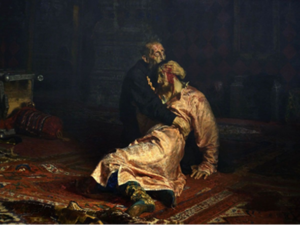
Nestled at the geometric centre of Moscow, Russia and gracing the southern side of the renowned ‘Red Square’, is a 16th century cathedral built to commemorate the victories of the first Tsar of Russia, Ivan IV, against the Tartars. This magnificent cathedral, popularly known as Cathedral of St. Basil the Blessed, can be easily mistaken as something straight out of the Aladdin movie in view of its enthralling architecture and colours. It’s not just the architecture of the cathedral but its own distinctive and entrancing history.
Intrinsically connected with the cathedral’s history is Ivan the ‘Terrible’ or Ivan IV- the first Tsar of all Russia (before him rulers of Muscovy were called Grand Princes). The reign of Ivan the Terrible is said to have established current Russian territories. The initial days of his rule were said to be peaceful and progressive. Back in the 16th Century the title ‘Terrible’ meant something close to ‘formidable’, ‘awe-inspiring’ but keeping in mind his nature, the epithet seems to fit its modern negative connotations too. The seeds of his ruthless behaviour were sown in his childhood and nurtured by the personal betrayals he faced in his life. His father died when Ivan was 3 and after that his mother ruled as a regent until her death when Ivan was 8. Caught up in the power struggle of the nobles, the trauma he experienced as a child shaped his personality- making him paranoid and ruthless in nature. Not only a troubled childhood, but personal tragedies like the defection of his friend and advisor Prince Kurubsky to the rival camp of Lithuanians in Ivan’s offensive to capture Livonia and the death of his beloved wife Anastasia made him more ruthless and more hostile towards the nobility. He suspected foul play behind Anastasia’s death and there are probabilities that his suspicions at times had valid grounds because according to recent research- Anastasia indeed died due to mercury poisoning. He is said to have executed thousands and also probably killed his son in a fit of rage. He was also assisted by the Oprichniki (a bodyguard corps established by Ivan the Terrible from 1565-1572) who terrorized the masses.
By the 15th century, the Mongolian Kipchak Khanate, comprising most of Russia, had disintegrated into several smaller Khanates. Ivan IV was able to defeat the last Mongol stronghold in Russia- Tartar City of Kazan. (as Turkish tribes became part of the Mongol armies of Genghis Khan, a fusion of the elements of the two resulted. These Mongols who invaded Russia and Hungary were known as Tatars in Europe). The Tsar, Ivan IV, decided to commemorate his victories by building the Cathedral. Built between 1555-1556, its official name was Cathedral of the Intercession on the Moat- because capture of Kazan occurred on the Feast of the Intercession of the Virgin in 1552 and ‘on the Moat’ is a reference to its position. But now it is popularly known as St. Basil’s Cathedral.

The structure was actually built by Ivan commemorating his victories but St. Basil is the one with whom the building is mostly associated. St. Basil was a ‘holy fool’, also referred to as ‘fool for Christ’. He is said to have possessed prophetic power and certain miracles have also been attributed to him. For instance, his prediction of fire at Moscow in 1597, fire at Novgorod during the feast of the Tsar and its subsequent miraculous containment. Even the unpredictable Czar Ivan IV is said to have revered him and some even suggest that he was probably scared of Basil. The structure was built by ‘the terrible’ but it has immortalized the name of ‘the blessed’.
The Cathedral’s architecture displays an east meets west element and the architects possibly took inspiration from Asian, Byzantine architecture and probably Italian Renaissance too. It cannot be said with definiteness who was the architect of the magnificent edifice but some stories suggest that the designers were two Russian architects Posnik and Barma and some suspect them to be the same person. Alternatively, some suggest that it was built by an Italian architect who was blinded by Ivan the Terrible after the completion of the cathedral so that such a structure would never be recreated elsewhere. The Cathedral includes a central church that is surrounded by nine secondary churches. Out of the nine encircling churches, eight are symbolic of Ivan’s victories over the Tartars and the final one- the only one at ground level- was added in 1588 by Tsar Fyodor I, son of Ivan IV, to house the tomb of Saint Basil.
Over the centuries the Cathedral had its fair share of momentous encounters. The Soviets made it a branch of the State History Museum in 1929. The building is still partly in use today as a museum but after the fall of the Soviet Union in the 1990s, religious services in the cathedral were resumed. The Cathedral was designated as a UNESCO world heritage site in 1990 and in 2001 one of the Seven Wonders of Russia.
This masterpiece which providentially survived the fury of Napoleon Bonaparte as well as Joseph Stalin today stands as a famed symbol of Russia. It continues its legacy to leave the visitors of the Red Square spellbound with its unusual, dream-like architecture and mélange of shades and motifs.
Great work Swati! Thanks for bringing the awesome architecture and its story from Russia to my phone. A story as thrilling as hamlet’s and as informative as an encyclopedia!